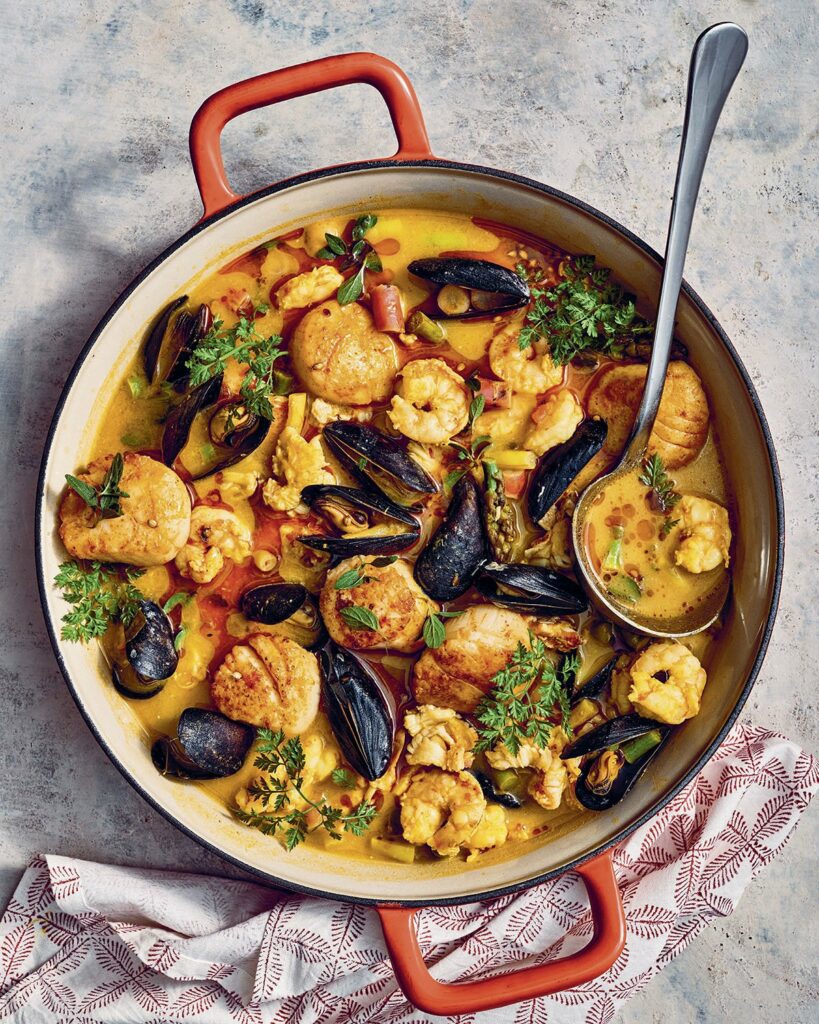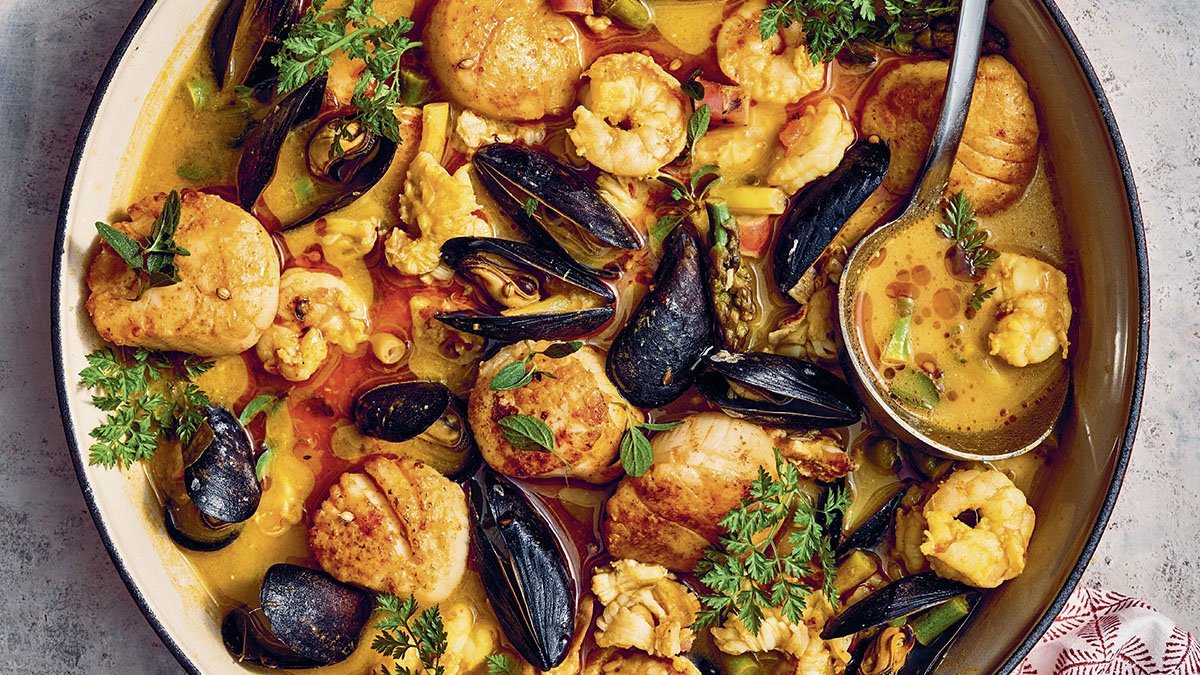 Legend has it that during colonial times in India, when a British officer in South India once asked his cook to prepare a soup as a starter, the cook was confused. The closest thing to a soup that the Tamil cook knew was a watery rasam (broth) made with black pepper or chiles, lentils, tamarind, and water, which in Tamil is called a molo tuny, or pepper water. The ingenious cook added some rice, a few vegetables, and a bit of meat and transformed this broth into what became known as mulligatawny. Mulligatawny soup was one of the earliest dishes to emerge from the new hybrid cuisine that local cooks developed in India to please the British, combining British concepts of how food should be presented with Indian spices. Most fancy hotels in India serve this soup, and I honestly have never had a restaurant version that I liked. This version has a velvety consistency and is hearty with vegetables and filled with flavor. The soup can be also be made with chicken or just vegetables and can be served with plain rice or warm crusty bread. The broth keeps in the freezer for up to 3 months.
Legend has it that during colonial times in India, when a British officer in South India once asked his cook to prepare a soup as a starter, the cook was confused. The closest thing to a soup that the Tamil cook knew was a watery rasam (broth) made with black pepper or chiles, lentils, tamarind, and water, which in Tamil is called a molo tuny, or pepper water. The ingenious cook added some rice, a few vegetables, and a bit of meat and transformed this broth into what became known as mulligatawny. Mulligatawny soup was one of the earliest dishes to emerge from the new hybrid cuisine that local cooks developed in India to please the British, combining British concepts of how food should be presented with Indian spices. Most fancy hotels in India serve this soup, and I honestly have never had a restaurant version that I liked. This version has a velvety consistency and is hearty with vegetables and filled with flavor. The soup can be also be made with chicken or just vegetables and can be served with plain rice or warm crusty bread. The broth keeps in the freezer for up to 3 months.
For the Garam Masala (Makes 1 cup)
1/4 cup green cardamom pods
6 large cinnamon sticks
5 star anise pods
5 black cardamom pods
1 teaspoon whole cloves
4 whole mace flowers
1 whole nutmeg
Garam masala, which literally translates to “warm spice blend” (meaning heating for the body) is the one masala that most Indian kitchens have tucked away in a cabinet. The recipes and proportions can vary wildly, but they will all possess a large amount of aromatic spices. Some will contain coriander and cumin. I prefer to leave it to aromatic spices, like the ones here, which adds a delicious heady finish to foods.
Preheat the oven to 300°F.
Combine all the spices in a small bowl. Spread them on a baking sheet and toast in the oven for 3 to 4 minutes, until fragrant. Let cool and grind in a coffee grinder to a powder.

Seafood Mulligatawny
Ingredients
- 1/4 cup toor dal
- 1 3-to 4-inch piece fresh turmeric
- 2 cups cauliflower florets
- 1 large carrot, cut into 1-inch pieces
- 1 3-to 4-inch piece ginger, roughly chopped
- 1 or 2 serrano chiles
- 2 teaspoons sea salt
- 1 14-ounce can coconut milk
- 1/4 cup ghee
- Generous pinch of asafetida
- 1 teaspoon black mustard seeds
- 20 kari leaves
- 2 large celery stalks, cut on the diagonal into 1-inch pieces
- 8 ounces french green beans, cut into 1-inch pieces
- 6 large scallops
- 8 ounces small shrimp, peeled and deveined
- 1 pound fresh mussels or clams
- 1 teaspoon garam masala (see recipe above)
- Juice of 1 lemon
- 1/2 cup chopped fresh cilantro
Instructions
- Rinse the dal two or three times in several changes of water, add water to cover by a couple of inches, and soak for 5 to 6 hours. Drain.
- In a large saucepan, combine the drained dal with 4 cups water and bring to a boil over high heat. Discard any scum that may arise—scum contains impurities that can make lentils hard to digest. (Alternatively, drain the dal, through a colander or strainer if needed, into the sink, add 4 cups fresh water, and bring to a boil again.) Add the turmeric, cauliflower, car- rot, ginger, chiles, and salt and bring to a boil. Lower the heat, cover, and simmer for 30 to 45 minutes, until the dal is dissolved to a mushy consistency and the vegetables are cooked through. Turn the heat off and let the soup rest. Puree in a blender, in batches if needed, until smooth and pour the soup back into the pot. Add the coconut milk, and if the soup is too thick, 1/2 to 1 cup water.
- Heat the ghee in a small frying pan over high heat. Pop the asafetida and mustard seeds (see page 40), add the kari leaves, and immediately scrape them into the soup. Stir in the celery and green beans, then add the scallops, shrimp, and mussels and cook for 2 to 3 minutes, until the vegetables are still bright green and the seafood is almost cooked through—it will continue to cook in the hot soup. Add the garam masala, lemon juice, and cilantro and serve.
Notes
 Reprinted with permission from Masala: Recipes from India, the Land of Spices by Anita Jaisinghani, copyright © 2022. Published by Ten Speed Press, an imprint of Penguin Random House. Photographs copyright © 2022 by Johnny Autry. Illustrations copyright © 2022 by Julie Keselman.
Reprinted with permission from Masala: Recipes from India, the Land of Spices by Anita Jaisinghani, copyright © 2022. Published by Ten Speed Press, an imprint of Penguin Random House. Photographs copyright © 2022 by Johnny Autry. Illustrations copyright © 2022 by Julie Keselman.

